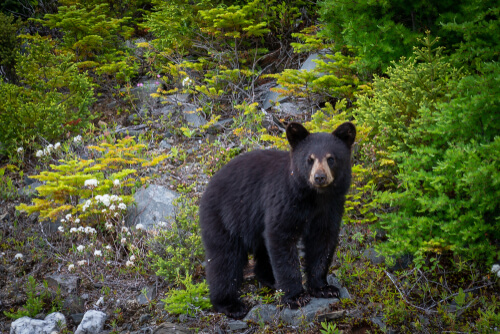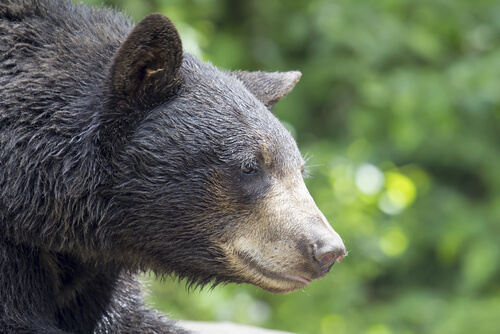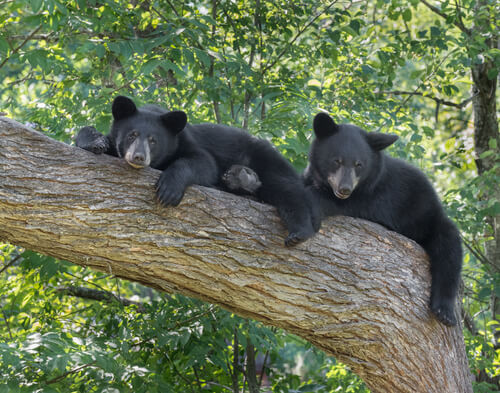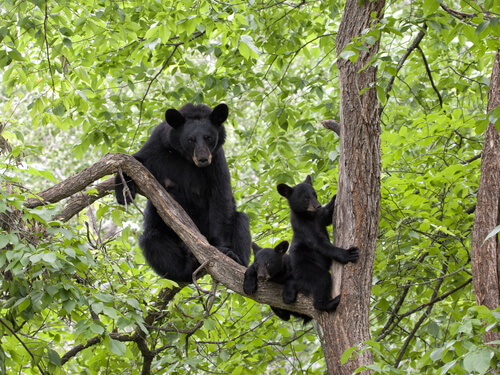
| Kingdom | Animalia |
| Phylum | Chordata |
| Class | Mammalia |
| Order | Carnivora |
| Family | Ursidae |
| Genus | Ursus |
| Species | Ursus americanus |
| Niche | Generalist Omnivore |
| Length | 4-6.5 ft (1.2-2.0 m) |
| Weight | 85-900 lb (39-409 kg) |
| Lifespan | 18 years |
| Social Structure | Territorial |
| Conservation Status | Least concern |
| Preferred Habitat | Dense forests and woodlands |
| Average Number of Offspring | 2-3 |
| Main Food Items and Prey Species | Roots, leaves, berries, small mammals, eggs, etc. |
| Predators | Wolves, cougars, humans |
The Basics
The American black bear is a large mammal of the family Ursidae native to North America. Among bears, it is medium-sized and can be found throughout Canada and the United States as well as some parts of Mexico, making it the world’s most common species of bear.
Description
Although typically black, various other color morphs and subspecies exist, including even white and cinnamon. Their muzzle is typically pale, and some may have a small white patch of chest fur. Males are generally about 4.5-6.5 ft (1.4-2.0 m) long from head to tail while females are slightly smaller, typically between 4-6 ft (1.2-1.6 m). Black bears vary in size depending on the region and the season, but typically weigh 85-900 lb (39-409 kg).

Their skulls are broad and their jaws are very powerful. They have mouths of sharp teeth including canines several inches long. Their large paws also have black or gray-brown claws that are short and rounded. Black bears have short vestigial tails and round, upright ears. Their fur is soft and consists of a dense underfur combined with longer, coarse guard hairs.
Distribution and Habitat
The range of the American black bear is vast, stretching throughout Canada and Alaska and into many parts of the USA and even north-central Mexico. Historically, its range was even greater but has been reduced and fragmented by human settlement and development since.
Within this range, black bears typically live in forested areas. The ideal black bear habitat is relatively inaccessible, among the thick vegetation of the forest subcanopy. However, with human development steadily increasing throughout much of their historic range, people continue to encroach on the natural habitat of this and many other species. Therefore, the American black bear has gained a reputation for being one of the most common bears found in human-occupied areas, typically attracted by poorly managed food and other attractants. Highly adaptable and with a generalist diet, they can be found from sea level to up to 10 000 ft (3 000 m) in mountainous regions.
Diet and Predators
Black bears are omnivores and eat a wide variety of food items. Their diets vary significantly between seasons and home ranges, but common items include berries, roots, eggs, small mammals, and birds, young ungulates. American black bears are also known to scavenge larger animals that have already died. They have strong eyesight and hearing and an even better sense of smell. Black bears are strong swimmers and will often enter the water to hunt fish if available in their habitat. They will usually forage at night, but this is determined based on the presence or absence of other threats like brown bears and humans.
Reproduction
Female black bears (sows) typically reach sexual maturity between 3-5 years of age. The breeding season tends to occur in the spring and early summer, typically for about 2-3 months. Both sexes are promiscuous, meaning they will mate with multiple partners within the same breeding season.

Following copulation, the fertilized egg undergoes delayed development and do not become embryos until roughly November of that same year. At this point, their gestation period of about 235 days begins, with 1-6 cubs finally being born in January or early February. Approximately 5 weeks later the cubs will open their eyes and begin walking. They are weaned by about 30 weeks and by about 16-18 months they become independent, setting out to find their own territory and mates. Female bears will often take up a territory adjacent to or overlapping with their mother’s territory while males will usually travel further afield. The average lifespan of American black bears in the wild is about 18 years although some specimens have been known to live longer.
Fun Facts about American Black Bear!
Black bears are the most common bears in the world due largely to their adaptability and generalist strategy. However, this also makes them one of the most commonly observed bears and the most likely bear species to part of a negative interaction with humans.
A Fed Bear is a Dead Bear
As humans continue to encroach on natural habitats around the world, interactions between people and wildlife are increasing. Black bears are notorious for being attracted to the smell of garbage and other waste products left behind by people. They will often hang around at dumps
However, like all wild animals, they have strong instincts that drive their behaviors such as guarding a food source. Although a bear may be in an area it doesn’t belong when scavenging for food waste such as garbage, it does not necessarily understand this. Many bears that have become accustomed to garbage as a food source may become aggressive in protecting it. Because this is such a dangerous situation, this often leads to these bears being euthanized by conservation officers or game wardens.
Thus, if you like bears and wish to protect them, it is your responsibility to do your part to make sure that there are no attractants for the animals where you live. Most bears will not hang around if they are not being rewarded with food and thus, situations like the euthanization of a bear are very easily avoided with a little awareness and diligence.
Although some populations are threatened, the species is the most commonly occurring bear in the world and is listed as “Least Concern” on the IUCN Red List of endangered species. Besides the brown bear which is also common, all other bear species are considered threatened with extinction.
Black is the New Brown
Despite their shared historical range in North America, black bears, and grizzly bears – also referred to as brown bears – are not particularly closely related, having diverged some 5.05 million years ago. The American black bear is instead more closely related to the Asian black bear (Ursus thibetanus), also known as the moon bear for its unique crescent-shaped white patch of fur on its chest.

Fascinatingly, the Asian black bear is largely adapted to an arboreal lifestyle, living largely in the trees. The American black bear can climb trees adeptly but uses them primarily as a refuge from threats rather than a regular habitat. This is especially true as black bears get older and larger. Brown bears, in contrast, are generally too large to climb trees with any kind of efficacy.
Despite their geographic isolation and distinct lifestyles, there are some similarities between the two black species. Helarctos malayanus, or the sun-bear, which also lives in Asia and has a crescent-shaped patch of fur on its chest, is also diverged from Ursus thibetanus and Ursus americanus relatively recently. There were likely more similar species in North America until the last glaciation periods 10,00 years ago. Afterward, the American black bear was left as the only bear species on the continent until the brown bear migrated to the continent via the land bridge connecting Eurasia with North America at the time.
The Spirit Bear
Not all black bears are black. Some subspecies are different colors such as dark brown or fawn. Perhaps most fascinatingly, there exists a small population of U. americanus in a remote part of coastal British Columbia, Canada. Known as Kermode or the Spirit Bear (Ursus americanus kermodei), approximately 10% of the members of this subspecies have a white or light color morph. The rest of the population – 90% – appear as regular black bears.
The Canadian Black Bear
The American Black Bear has been largely extirpated from much of its historic range. The species’ present-day range still extends into much of the US west coast and east coast as well as some fragmented populations along the Rocky Mountains and Sierra Nevadas and down into northern Mexico. However, most bears can be found in Canada where their distribution is still largely unfragmented.
